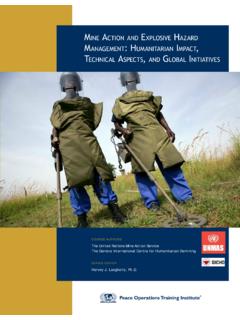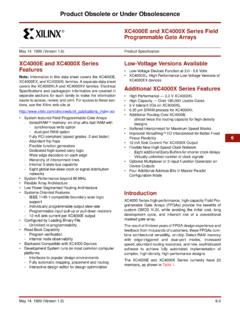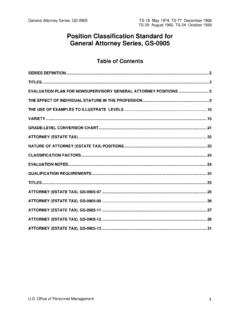Transcription of Time Series Analysis and Its Applications: With R Examples ...
1 For other titles published in this Series , go to G. Casella S. Fienberg I. Olkin Editors Springer Texts in Statistics Robert H. Shumway David S. StofferWith R ExamplesIts ApplicationsThird editionTime Series Analysis and subject to proprietary rights. Printed on acid-free paper Springer is part of Springer Science+Business Media ( ) ISSN 1431-875 XSpringer New York Dordrecht Heidelberg London Springer Science+Business Media, LLC 2011 All rights reserved. This work may not be translated or copied in whole or in part without the writtenpermission of the publisher (Springer Science+Business Media, LLC, 233 Spring Street, New York,NY 10013, USA), except for brief excerpts in connection with reviews or scholarly Analysis .
2 Use in connection with any form of information storage and retrieval, electronic adaptation, computer software, or by similar or dissimilar methodology now known or hereafter developed is forbidden. The use in this publication of trade names, trademarks, service marks, and similar terms, even if they are not identified as such, is not to be taken as an expression of opinion as to whether or not they are ISBN 978-1-4419-7864-6 DOI University of CaliforniaDavis, CaliforniaDepartment of StatisticsUSAD epartment of Statistics University of Pittsburgh Pittsburgh, PennsylvaniaProf.
3 David S. Stoffere-ISBN 978-1-4419-7865-3 USA Prof. Robert H. ShumwayTo my wife, Ruth, for her support and joie de vivre, and to thememory of my thesis adviser, Solomon my family and friends, who constantly remind me what Preface to the Third EditionThe goals of this book are to develop an appreciation for the richness andversatility of modern time Series Analysis as a tool for analyzing data, and stillmaintain a commitment to theoretical integrity, as exemplified by the seminalworks of Brillinger (1975) and Hannan (1970) and the texts by Brockwell andDavis (1991) and Fuller (1995).
4 The advent of inexpensive powerful computinghas provided both real data and new software that can take one considerablybeyond the fitting of simple time domain models, such as have been elegantlydescribed in the landmark work of Box and Jenkins (1970). This book isdesigned to be useful as a text for courses in time Series on several differentlevels and as a reference work for practitioners facing the Analysis of time-correlated data in the physical, biological, and social have used earlier versions of the text at both the undergraduate andgraduate levels over the past decade.
5 Our experience is that an undergraduatecourse can be accessible to students with a background in regression analysisand may include , , the results and numerical parts of , and briefly the results and numerical parts of At the advancedundergraduate or master s level, where the students have some mathematicalstatistics background, more detailed coverage of the same sections, with theinclusion of and extra topics from Chapter 5 or Chapter 6 can be used asa one-semester course. Often, the extra topics are chosen by the students ac-cording to their interests. Finally, a two-semester upper-level graduate coursefor mathematics, statistics, and engineering graduate students can be craftedby adding selected theoretical appendices.
6 For the upper-level graduate course,we should mention that we are striving for a broader but less rigorous levelof coverage than that which is attained by Brockwell and Davis (1991), theclassic entry at this major difference between this third edition of the text and the secondedition is that we provide R code for almost all of the numerical Examples . Inaddition, we provide an R supplement for the text that contains the data andscripts in a compressed file ; the supplement is available on thewebsite for the third edition, ,viiiPreface to the Third Editionor one of its mirrors.
7 On the website, we also provide the code used in eachexample so that the reader may simply copy-and-paste code directly into details are given in Appendix R and on the website for the R is new to this edition, and it includes a small R tutorial as wellas providing a reference for the data sets and scripts included Sothere is no misunderstanding, we emphasize the fact that this text is abouttime Series Analysis , not about R. R code is provided simply to enhance theexposition by making the numerical Examples have tried, where possible, to keep the problem sets in order so that aninstructor may have an easy time moving from the second edition to the thirdedition.
8 However, some of the old problems have been revised and there aresome new problems. Also, some of the data sets have been updated. We addedone section in Chapter 5 on unit roots and enhanced some of the presenta-tions throughout the text. The exposition on state-space modeling, ARMAX models, and (multivariate) regression with autocorrelated errors in Chapter 6have been expanded. In this edition, we use standard R functions as much aspossible, but we use our own scripts (included ) when we feel itis necessary to avoid problems with a particular R function; these problemsare discussed in detail on the website for the text under R thank John Kimmel, Executive Editor, Springer Statistics, for his guid-ance in the preparation and production of this edition of the text.
9 We aregrateful to Don Percival, University of Washington, for numerous suggestionsthat led to substantial improvement to the presentation in the second edition,and consequently in this edition. We thank Doug Wiens, University of Alberta,for help with some of the R code in Chapters 4 and 7, and for his many sug-gestions for improvement of the exposition. We are grateful for the continuedhelp and advice of Pierre Duchesne, University of Montreal, and AlexanderAue, University of California, Davis. We also thank the many students andother readers who took the time to mention typographical errors and othercorrections to the first and second editions.
10 Finally, work on the this editionwas supported by the National Science Foundation while one of us ( )was working at the Foundation under the Intergovernmental Personnel , CARobert H. ShumwayPittsburgh, PADavid S. StofferSeptember 2010 ContentsPreface to the Third Edition.. vii1 Characteristics of Time Series .. Introduction .. The Nature of Time Series Data .. Time Series Statistical Models .. Measures of Dependence: Autocorrelation andCross-Correlation .. Stationary Time Series .. Estimation of Correlation .. Vector-Valued and Multidimensional Series .








